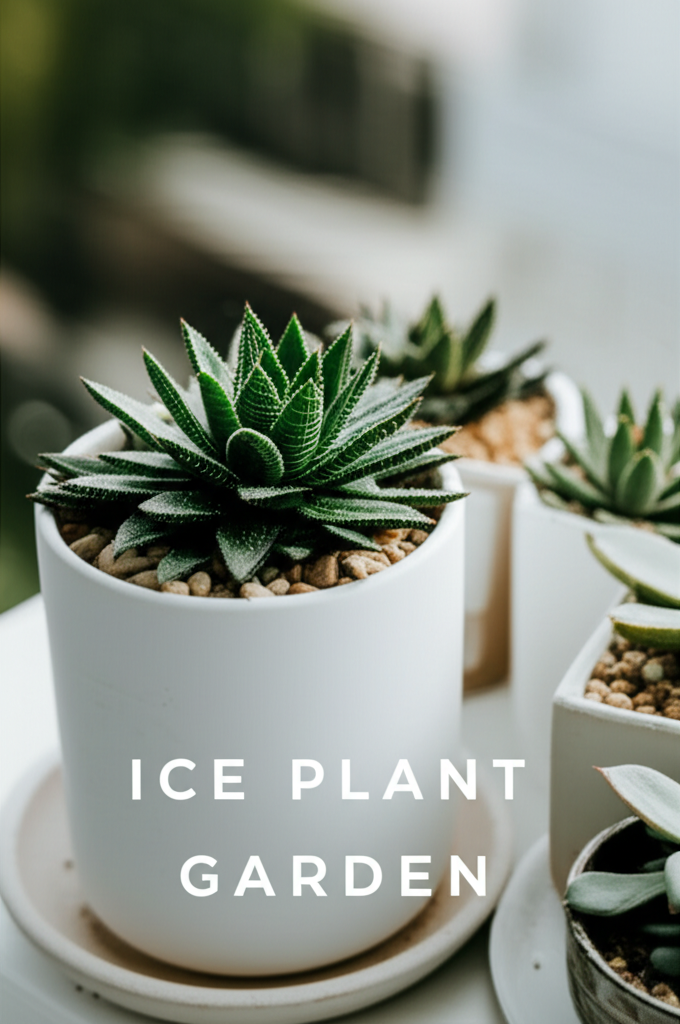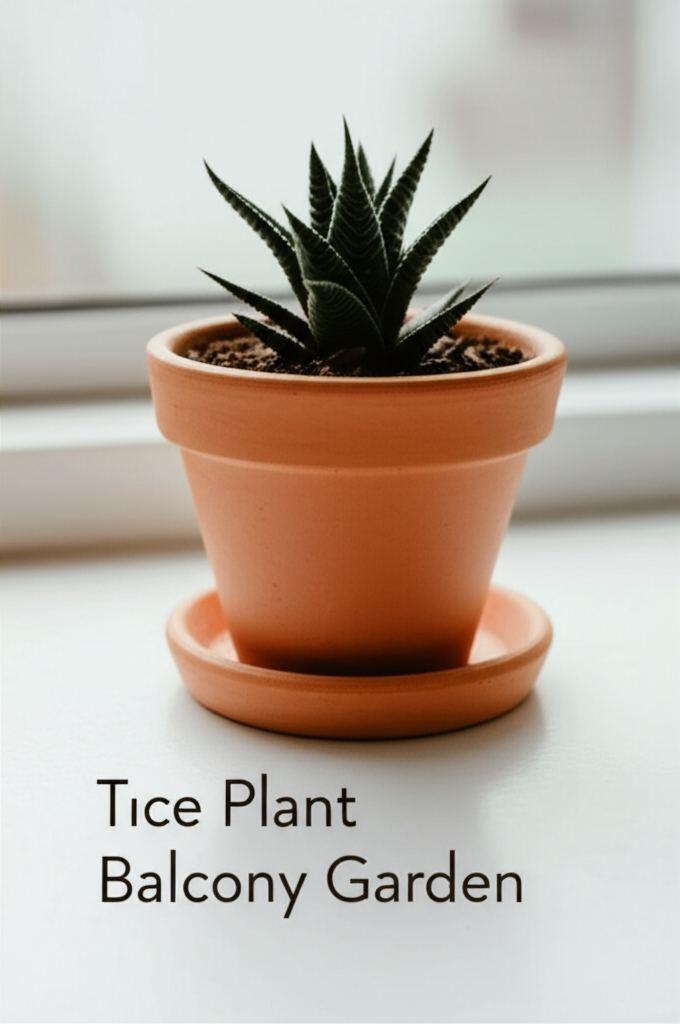Introduction: Unveiling the Charm of Ice Plant Succulents for Compact Spaces
Transforming a small indoor balcony into a vibrant oasis often involves strategic plant selection. For those seeking low-maintenance beauty and a touch of the exotic, ice plant succulents, with their jewel-like foliage and dazzling blooms, offer an unparalleled solution. These resilient plants, belonging to the Aizoaceae family, are renowned for their unique water-storing cells that glisten like ice, especially in the morning sun. This article will guide you through the exciting process of designing and maintaining a captivating ice plant succulent table garden specifically tailored for the intimate confines of your indoor balcony. We’ll explore the diverse varieties, optimal care requirements, and creative layout ideas to maximize both aesthetic appeal and plant health, turning your petite space into a miniature botanical paradise.
Understanding Ice Plant Succulents: More Than Just Pretty Faces

Before diving into the specifics of table garden design, it’s crucial to appreciate what makes ice plant succulents so special. Their common name, “ice plant,” refers to the characteristic papillae or vescicles on their leaves and stems. These translucent, watery cells reflect sunlight, giving the appearance of being covered in frost or ice crystals. This adaptation is vital for survival in arid environments, allowing them to capture and store precious moisture.
Key Characteristics and Benefits for Indoor Balconies
- Drought Tolerance: Ice plants are masters of water conservation, making them ideal for busy individuals or those prone to forgetting watering schedules.
- Low Maintenance: Beyond occasional watering and adequate sunlight, they require minimal fuss, fitting perfectly into a low-maintenance lifestyle.
- Dazzling Blooms: Many varieties produce an abundance of daisy-like flowers in a spectrum of vibrant colors, from bright yellows and oranges to soft pinks and whites.
- Compact Growth Habit: Numerous species naturally grow as low-spreading mats or small mounds, making them perfect for container gardening and table displays.
- Unique Textures and Colors: The diverse forms and the characteristic “ice” covering offer a visually intriguing addition to any plant collection.
- Air Purification: Like many houseplants, succulents can contribute to improved indoor air quality.
A Glimpse at Popular Ice Plant Varieties for Table Gardens
The world of ice plant succulents is vast and varied. For an indoor balcony table garden, focusing on compact and visually striking varieties is key.
Delosperma (Ice Plant):
This is perhaps the most recognized genus. Varieties like Delosperma cooperi (Cooper’s Ice Plant) are known for their prolific pink to purple flowers and mat-forming habit, making them excellent ground cover in larger arrangements or as standalone cascading plants in shallow containers.
Lithops (Living Stones):
While not strictly “ice plants” in the common parlance of Delosperma, Lithops are highly specialized succulents belonging to the Aizoaceae family. Their remarkable resemblance to pebbles or stones is a masterclass in camouflage. They are exceptionally compact and require very careful watering, making them a fascinating addition for the experienced succulent enthusiast. Their unique appearance adds an artistic element to a minimalist table garden.
Mesembryanthemum (Vygies):
This broad genus includes many species, some of which are referred to as ice plants. Mesembryanthemum crystallinum (Common Ice Plant) is a well-known example, though it can grow larger than ideal for a tiny table. However, dwarf cultivars or other Mesembryanthemum species with similar ice-like papillae can be suitable.
Conophytum (Pebble Plants):
Similar to Lithops, Conophytum species are miniature succulents that cluster together, resembling tiny pebbles or raindrops. Their small size and unique shapes make them ideal for creating intricate, miniature landscapes in shallow dishes.
Key Facts Comparison: Ice Plant Succulent Varieties
To help you choose the best ice plants for your table garden, here’s a comparison of some popular options:
| Variety | Genus | Typical Flower Color | Growth Habit | Watering Needs | Sunlight Requirements | Ideal for Table Garden |
|---|---|---|---|---|---|---|
| Cooper’s Ice Plant | Delosperma | Pink, Purple | Mat-forming, trailing | Low to Moderate (allow to dry between waterings) | Full Sun | Excellent (cascading or ground cover) |
| Living Stones | Lithops | Yellow, White, Pink | Dwarf, solitary or clustered | Very Low (infrequent, specific dormancy periods) | Full Sun | Excellent (artistic, minimalist displays) |
| Pebble Plants | Conophytum | Yellow, Orange, Pink, White | Dwarf, clumping | Low (allow to dry thoroughly) | Bright Indirect to Full Sun | Excellent (miniature landscapes, focal points) |
Designing Your Indoor Balcony Table Garden: Layout and Container Selection
The success of your ice plant succulent table garden hinges on thoughtful design. Considering the limited space of an indoor balcony, every element should be chosen with purpose.
Choosing the Right Containers
The container is the foundation of your table garden. For ice plants, good drainage is paramount.
- Material: Terracotta pots are excellent as they are porous and allow for better aeration and faster drying, which succulents prefer. Glazed ceramic pots can also work, but ensure they have drainage holes. Avoid plastic pots unless they have ample drainage.
- Size and Depth: Opt for shallow, wide containers like bonsai pots, troughs, or shallow bowls. This allows for multiple plants to be displayed aesthetically, showcasing their unique growth habits. Ensure each container has at least one drainage hole.
- Drainage: This cannot be stressed enough. If a decorative pot lacks drainage holes, consider using it as a cachepot, placing a smaller nursery pot with drainage inside.
Creative Layout Ideas for a Small Space
The goal is to create a visually appealing arrangement that thrives.
- The Monochrome Majesty: Select ice plant varieties with similar flower colors but varying textures and forms. This creates a subtle yet sophisticated display.
- The Contrasting Collection: Pair ice plants with different bloom colors and foliage textures. For instance, the vibrant pinks of Delosperma can be beautifully contrasted with the muted greens and browns of Lithops or Conophytum.
- The Mini-Landscape: Use shallow containers and arrange plants to mimic a desert landscape. Incorporate decorative gravel, small rocks, or sand to enhance the visual theme. Place taller, more upright specimens strategically amongst lower-growing mat-formers.
- The Cascading Wonder: Utilize hanging baskets or tall containers placed on a table to allow trailing ice plant varieties to spill over the edges, adding vertical interest.
- The Focal Point: Design a central arrangement with a particularly striking ice plant, surrounded by smaller, complementary specimens.
Essential Care for Thriving Ice Plants on Your Balcony
Even low-maintenance plants require specific care to flourish. Ice plants are no exception, and their needs are relatively straightforward.
Sunlight: The Golden Rule
Ice plants are sun-worshippers. For optimal growth and flowering, they need at least 6 hours of direct sunlight per day. If your indoor balcony doesn’t receive sufficient direct sun, consider placing them in the brightest spot possible and supplementing with a grow light. Insufficient light will lead to leggy growth (etiolation) and fewer blooms.
Watering: The Delicate Balance
Overwatering is the most common killer of succulents.
- Frequency: Water thoroughly only when the soil has completely dried out. This might be every 2-4 weeks, depending on the season, humidity, and pot size.
- Method: Water the soil directly, avoiding the foliage as much as possible, especially for varieties with fleshy leaves. Allow excess water to drain away completely.
- Dormancy: Some ice plants, like Lithops, have distinct dormancy periods (often in summer or winter) where watering should be significantly reduced or stopped altogether. Research the specific needs of your chosen varieties.
Soil and Drainage: The Perfect Mix
A well-draining soil mix is crucial.
- Composition: Use a specialized succulent or cactus potting mix. Alternatively, create your own by mixing 2 parts potting soil with 1 part perlite and 1 part coarse sand or pumice.
- Avoidance: Do not use standard potting soil alone, as it retains too much moisture.
Temperature and Ventilation
Ice plants generally prefer warm temperatures during the growing season and cooler temperatures during their dormant period. Average room temperatures are usually suitable. Good air circulation is important to prevent fungal diseases, especially in humid environments.
Fertilizing: A Light Touch
Ice plants are not heavy feeders. Fertilize sparingly, perhaps once or twice during the active growing season (spring and summer) with a diluted, balanced liquid fertilizer or a cactus-specific fertilizer. Avoid fertilizing during their dormant periods.
Step-by-Step Guide: Creating Your Table Garden
Here’s a breakdown of how to assemble your ice plant succulent table garden:
Step
Action
Considerations
1
Select Containers
Choose shallow, wide containers with drainage holes (terracotta recommended).
2
Prepare Soil Mix
Use a well-draining succulent/cactus mix or create your own.
3
Arrange Plants (Dry Run)
Place plants in containers without soil to visualize the layout and ensure aesthetic balance.
4
Planting
Fill containers with soil mix, leaving space for plants. Gently remove plants from nursery pots, loosen any compacted roots, and position them in the containers. Add more soil around the roots, pressing down lightly.
5
Top Dressing (Optional)
Add a layer of gravel, pebbles, or decorative sand to the soil surface. This helps with drainage, prevents the base of the plants from staying wet, and adds a finished look.
6
Initial Watering (Cautious)
Wait a few days to a week after planting before watering. This allows any damaged roots to heal, reducing the risk of rot. When you do water, water thoroughly until it drains from the bottom.
7
Placement
Position your finished table garden in a location that receives ample sunlight (at least 6 hours).
Troubleshooting Common Issues
Even with careful planning, occasional problems can arise.
Etiolation (Stretching and Legginess)
Cause: Insufficient sunlight.
Solution: Move plants to a brighter location. If natural light is limited, invest in a grow light. You can propagate the leggy stems by cuttings.
Root Rot
Cause: Overwatering and poor drainage.
Solution: If caught early, unpot the plant, remove all rotten tissue, and repot in dry, well-draining soil. Avoid watering until the soil is completely dry. Ensure your containers have drainage holes.
Pests (Mealybugs, Aphids)
Cause: Can be introduced from other plants or environmental factors.
Solution: Isolate affected plants. Treat with a cotton swab dipped in rubbing alcohol or a horticultural insecticidal soap. For severe infestations, consider neem oil.
Lack of Blooming
Cause: Insufficient sunlight, incorrect watering, or lack of a dormant period.
Solution:** Ensure plants are receiving adequate light. Adjust watering practices. If a specific variety requires a dormant period, mimic those conditions.
Pros and Cons of an Ice Plant Succulent Table Garden
Here’s a balanced look at the advantages and disadvantages:
| Pros | Cons |
|---|---|
| Low Maintenance: Excellent for busy individuals. | Sunlight Dependent: Requires significant direct sunlight. |
| Drought Tolerant: Forgiving of occasional neglect in watering. | Risk of Overwatering: Overwatering leads to root rot. |
| Visually Striking: Unique foliage and vibrant blooms. | Specific Soil Needs: Requires well-draining soil. |
| Compact Size: Ideal for small spaces like balconies. | Pest Susceptibility: Can be prone to mealybugs if not monitored. |
| Enhances Ambiance: Adds beauty and a touch of nature. | Dormancy Requirements: Some varieties need specific dormancy periods. |
| Educational: Offers a chance to learn about succulent adaptations. | Limited Cold Tolerance: Not suitable for unheated outdoor balconies in freezing climates. |
Conclusion: Cultivating Your Miniature Desert Dream
Creating an ice plant succulent table garden for your indoor balcony is a rewarding endeavor. By understanding the unique needs of these resilient plants and applying thoughtful design principles, you can cultivate a captivating display that brings a splash of vibrant color and intriguing texture to your limited outdoor space. From the dazzling blooms of Delosperma to the intriguing forms of Lithops and Conophytum, the world of ice plants offers a miniature desert to explore and enjoy. Embrace the simplicity, admire the resilience, and let your tiny balcony bloom with the cool, crystalline charm of ice plant succulents.


